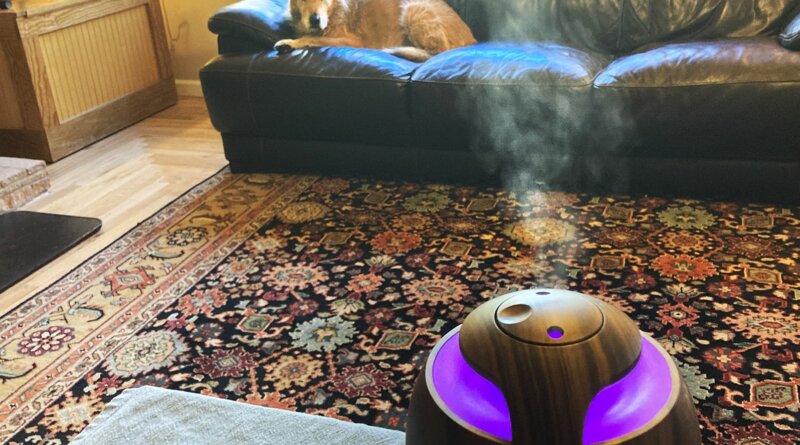How to Identify and Buy Therapeutic-Quality Essential Oils
Aromatherapy diffusers release essential oils, scenting the air with chemicals that affect minds and bodies. Depending on the oils it contains, a diffuser can help calm an anxious dog, lift a sad dog’s spirits, address specific symptoms, or help clear an area of airborne pathogens.
Are diffusers BAD for dogs?
Any improperly used essential oil or aromatherapy accessory can harm your canine best friend, so it’s important to understand how essential oil diffusers work and how to use them safely. If you follow the advice of experienced canine aromatherapists and use only therapeutic-quality oils that are safe for dogs, diffusers are good, not bad, for dogs.
Which diffuser type is best for dogs?
There are several types of diffusers:
A simple passive diffuser (cotton ball, tissue, fabric, or piece of clay) holds a drop of oil in place while it evaporates.
A candle or heat diffuser consists of a ceramic or glass bowl that sits on top of a tea light or gentle heating element. Drops of essential oil placed in the bowl with or without water evaporate as the bowl is warmed.
An ultrasonic diffuser disperses essential oil molecules in a cool mist. Place water in the diffuser’s reservoir, add 3 to 5 drops of essential oil, and sound waves generated by the diffuser’s metal disc will agitate the water, vaporizing essential oil molecules. A built-in fan carries the scented mist into the room.
A nebulizing diffuser produces a mist without the use of water by breaking essential oils into fine particles. Nebulizing diffusers produce the most concentrated aromatherapy mists.
Aromatherapist Frances Fitzgerald Cleveland at Frogworks in Littleton, Colorado, has been blending essential oils for animals since 1996. She prefers ultrasonic diffusers because they are more efficient than passive or heat diffusers; they are also less intense and safer than nebulizing diffusers for use around pets.
Cleveland recommends using an ultrasonic diffuser that can release an essential oil mist for 15 to 30 minutes and then turn itself off. She explains, “After 30 minutes the olfactory system is saturated with essential oils and needs relief from the aromas. Diffusing essential oils for too long can create the opposite effect from what you are trying to make.” If you feel another dose is needed, wait at least three to four hours before the next inhalation.
Benefits of diffused essential oils
Diffused essential oils do far more than smell fragrant. Inhaled essential oils, says Cleveland, affect every part of the body: They enter through the nose, then move to the olfactory region, lungs, brain, bloodstream, cerebrospinal fluid, tissue, and internal organs before being excreted by the kidneys.
In her book The Aromatic Dog: Essential Oils, Hydrosols, and Herbal Oils for Everyday Dog Care: A Practical Guide (Off the Leash Press, 2015), British aromatherapist Nayana Morag recommends diffusion for:
- Fears and phobias, including fireworks.
- Separation anxiety and other mental stress.
- Tension in relationships between dogs and other animals or people.
- Clearing airborne bacteria, preventing the spread of disease.
In addition, diffusers can:
- Freshen your home by helping to remove odors.
- Promote deep breathing.
- Relieve stress.
- Help with training by boosting your dog’s concentration and focus.
- Help dogs recover from accidents or injury by promoting deep rest and recuperation.
Where to place your diffuser
Position your diffuser so it’s out of your dog’s reach and safe from being explored or knocked over. Don’t place it directly on rugs, upholstery, or wood furniture that could be harmed by spills or humidity.
“When you use an ultrasonic diffuser,” says Cleveland, “the diffused essential oils will drift through the room so that all who are in the room will inhale them.” She recommends placing the diffuser on a counter or table in a well-ventilated room with at least one open door, so that the dog being treated has a way to leave the room if he decides to do so. “For example,” she says, “don’t put your dog in a closet with a diffuser.”
Let your dog choose
Cleveland practices zoopharmacognosy, a term that describes how animals self-medicate with plants and soils to treat and prevent disease.
“For any condition, there are several essential oils that could help,” she says. “I let the dog smell each of them, usually by offering the cap. If she runs to the other side of the room or turns her head away, that’s not the right oil to use. Don’t ever force an essential oil on your dog. Wait for her to find an oil she’s interested in, one that she wants to smell more of. She may even try to lick the cap.”
What essential oils are safe for dogs?
Cleveland’s favorite essential oils to diffuse around dogs are bergamot, frankincense, and vetiver. Lavender is recommended at most aromatherapy websites, but over the years, Cleveland has noticed very few dogs choosing lavender essential oil, so she recommends offering alternatives.
The essential oil of bergamot (Citrus bergamia) is pressed from the peel of this plant’s fruit and is recommended for anxiety, depression, and stress-related conditions. “Its cooling and refreshing quality seems to soothe anger and frustration,” says Cleveland. “Some sources warn that bergamot is toxic to pets, but I have diffused it for more than 20 years with no problems. I use it to help dogs with depression, the loss of a loved one, and anxiety. This is a great oil for rehabilitating abused animals.”
One of bergamot’s chemical constituents is bergapten, which makes topically applied bergamot phototoxic to humans and animals, so make sure you buy only bergapten-free bergamot oil.
Frankincense (Boswellia carteri) exudes a rich, warm, sweet balsamic aroma. It has been reported to help with asthma, bronchitis, coughs, anxiety, and nervous tension. Cleveland says that it is frequently chosen by dogs suffering from anxiety and fear.
Vetiver (Vetiveria zizanoides) is a tranquil, calming, and grounding oil that helps soothe irritability and anger. Cleveland says, “It has a balancing effect on the central nervous system and is helpful for mental and physical exhaustion and insomnia.”
The oils in the chart below include Cleveland’s three favorite aromatherapeutic oils for dogs; the rest are favorites of Kristen Leigh Bell, author of Holistic Aromatherapy for Animals (Findhorn Press, 2002).
What essential oils are bad for dogs?

“Do not diffuse essential oils with the constituent thujone,” says Cleveland, “such as sage, tansy, and wormwood.” Other potentially harmful essential oils for dogs include peppermint, cinnamon, wintergreen, pine, sweet birch, tea tree (Meleleuca), anise, clove, and ylang-ylang.
According to the Pet Poison Helpline (855-764-7661), the most frequently reported essential oil toxicities for dogs involve tea tree, pennyroyal, wintergreen, and pine oils.
In general, the risk to dogs from aromatherapy diffusers is minimal, especially if you use essential oils from the “safe for dogs” list and follow the recommendations described in this article.
Off-Leash Genetics
For best results, dog owners must be sure the essential oils they buy are of “therapeutic quality.” Be forewarned, however, that there is much confusion in the marketplace as to how that term is defined. Fortunately, at the high end, there is also much agreement as to what’s the best and what isn’t. Professional aromatherapists agree that more than 95% of the world’s production of essential oils, including most brands sold in department stores and health food stores, are inappropriate for canine (or human) aromatherapy.
Most essential oils are chemically standardized for the pharmaceutical and perfume industries, with certain components removed and others added. Even if they are correctly labeled as 100% natural and 100% pure, nearly all essential oils are produced from commercially grown plants, complete with traces of pesticides and chemical fertilizers, and they are quickly distilled in very large batches under high heat and pressure for maximum yield. The results are very different from oils distilled in small batches at low pressure for longer periods.
The best sellers of essential oils source their products directly from manufacturers (distillers) or from distributors who travel to the source. They test the oils with gas chromatography or similar sophisticated equipment to ensure the oils are correctly labeled and not adulterated with synthetic oils, pesticide residues, or anything else.
The best oils are made with plants that are organically raised or responsibly wild-crafted; distilled at low temperature and pressure; treated like vintage wines and never blended with other essential oils; labeled by botanical species according to the date, time, and place of harvest and distillation; and tested for purity and accuracy of chemotype.
Any product that contains synthetic essential oils should not be used for therapeutic purposes. Pure essential oils are very expensive, so some distributors adulterate them with synthetic oils, inexpensive natural oils with a similar fragrance, inexpensive vegetable oils, or solvents. Obviously, these adulterants and synthetic oils – sometimes called perfume or fragrance oils – do not offer the complex chemicals contained in natural essential oils.
Approved Essential Oil Suppliers
To find true therapeutic-quality essential oils, order from suppliers like the ones listed below. These suppliers test essential oils for quality and maintain a network of relationships with manufacturers whose products are truly of superior quality. They are also familiar with safe canine applications for their products.
Safe Essential Oils for Use in a Diffuser for Dogs
| Essential oil | Indicated for |
| Bergamot (Citrus bergamia) | Relaxing, uplifting, reduces anxiety |
| CARROT SEED (Daucus carota) | Relaxing, relieves stress and anxiety |
| ROMAN CHAMOMILE (Anthemis nobilis) | Calming, for behavioral concerns, anxiety |
| Frankincense (Boswellia carteri) | Balancing, lifts the spirit, boosts immunity |
| GERMANIUM (Pelargonium graveolens) | Stress relief, raises spirits |
| GINGER (Zingiber officinale) | Helps prevent nausea |
| LAVENDER (Lavandula angustifolia) | Calming, relaxing |
| GREEN MANDARIN (Citrus reticulata) | Calms fear, anxiety, stress |
| SWEET MARJORAM (Origanum marjorana) | Calming, disinfecting |
| MYRRH (Commiphora myrrha) | Antiviral, helps with healing |
| SWEET ORANGE (Citrus sinensis) | Calming, deodorizing, raises spirits |
| ROSE (Rosa damascene) | Encouraging, relaxes mind and body |
| THYME (Thyme vulgaris, chemotype linalool) | Relaxing, antibacterial, supports immune system |
| VALERIAN (Valeriana officinalis) | Calming, separation anxiety, thunder phobia, sleep aid |
| Vetiver (Vetivera zizanoides) | Stabilizing, balancing, strengthens immune system |




